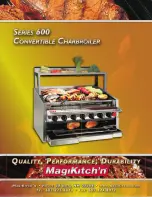
8
Super Plus -
Installation and Servicing
6.
Flue products must not be allowed to enter the
boilerhouse or adjacent buildings.
7.
Refer also BS.6644 and to IGE/UP/10 Installation of Gas
Appliances in Industrial and Commercial Premises and IM/22
for further guidance.
AIR SUPPLY
Detailed recommendations for air supply are given in BS.6644
which MUST be consulted before proceeding.
Contamination of the air supply from any external source must be
avoided - with particular reference to dust, insulation debris, and
flue products and concrete floors must be sealed. If any work is to
be carried out in the boilerhouse which is likely to generate dust
(e.g. structural alterations or lagging pipework), it is recommended
that the boiler be shut down and the modules covered with a dust
sheet, otherwise the boiler may require cleaning and servicing.
1.
In particular the contamination of the air supply with chlorides
must be avoided as they will cause the deterioration of the
aluminium heat exchanger.
2.
The boiler requires ventilation openings at BOTH high and low
levels, direct from outside, and allowance MUST be made for
stabiliser dilution in all cases.
3.
Mechanically forced ventilation systems must include provision
for boiler shut down in the event of fan failure.
4
. High speed air streams within the boilerhouse must be
avoided.
5.
Extraction mounted ventilation fans alone are NOT permitted.
6.
The minimum effective areas of the permanent air vents direct
from the outside by natural ventilation are as follows:
Required area (cm
2
) per kW of total rated input (net)
Boiler room
Enclosure
Low level (inlet)
4
10
High level (outlet)
2
5
Note: Where a boiler installation is to operate in summer
months (e.g. DHW) additional ventilation requirements
are stated, if operating for more than 50% of time (refer to
BS6644).
7.
The minimum air requirements by mechanical ventilation
are as follows:
Table 2
Mechanical ventilation flow rates
Type of boiler
Flow rate per KW total rated heat input (net)
Inlet air
Extract
(Combustion
air
ventilation) (ventilation)
Forced/induced
2.6 m
3
/h 1.25m
3
/h
draught boilers
± 0.18m
3
/h
A purpose designed flueing ventilation system based solely on a
high level permanent opening to an otherwise sealed boiler-house
or compartment may be used, provided that specialist advice is
taken and that the combustion air and ventilation requirements of
the boiler is provided in line with BS.6644. In addition this boiler
house temperature must be prevented from exceeding 32
o
C at
mid-level. BS 6644 provides details of temperature requirements.
LOCATION
The floor must be flat, level and capable of supporting the weight
of the WET boiler pipework. In addition, concrete floors must
be sealed. The siting of the boiler must be in accordance with
the guidance given in BS.6644 and with reference to minimum
boilerhouse clearances - refer to Fig. 5.
Inflammable materials MUST NOT be placed in close proximity to
the appliance. Materials giving off flammable vapours MUST NOT
be stored in the same room as the appliance.
Fig.5 Recommended Boiler House Clearances
for Comfortable Servicing Access (Plan View)
Note:
Headroom must be the boiler height
(Table 1) Plus any pipework and flue
requirements
CONNECTION TO GAS SUPPLY
The gas installation MUST be in accordance with the requirements
of the local gas region (refer also to CP 331:3 and CP 332:3 where
applicable).
The gas supply must be capable of maintaining a minimum pressure
as indicated in Table 1, measured at the inlet to the boiler, with all
modules firing (gas consumption is given in
Table 1.) Static inlet pressure should not exceed 50 mb.
The boilers are for use with NATURAL GAS ONLY.
FLUE REQUIREMENTS
Open flue, induced draught and fan diluted systems may be used
but must comply with the following basic requirements:
1.
A draught diverter MUST NOT be fitted.
2.
A draught stabiliser MUST be fitted to all types of flue systems
and set to control the draught in the casing between neutral and
0.2 mbar (0.08 in.w.g.) irrespective of flue height or number of
modules firing. (see Figs. 6 and 7 for further guidance).
3.
ALL flue systems must be insulated and/or lined and impervious
to acid condensate. Prefabricated chimneys must have a 'U'
value of no greater than 1.4 W/m
2 o
C at 540
o
C (0.25 Btu/h ft
2
0
F at 1000
o
F).
4.
Drainage must be provided at the base of the chimney or liner.
(All boiler casings have a condensate drain point - see Fig. 17)
5.
For fan diluted or induced draught systems, air flow/pressure
switches MUST be fitted to protect against fan failure. Switches
should be set to open if the air flow reduces by more than 15%.
900
(352)
500
(19
1
/
2
)
25(1)
500
(19
1
/
2
)
GENERAL
GENERAL









































